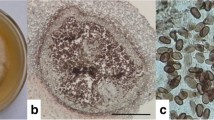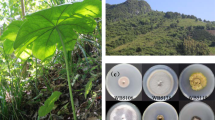Abstract
Podophyllotoxin, a well-known naturally occurring aryltetralin lignan occurs in few plant species that is used as a precursor for the chemical synthesis of the anticancer drugs like etoposide, teniposide and etopophose phosphate. The availiability of this lignan is becoming increasingly limited because of the scarce occurance of its natural sources and also because synthetic approaches for its production are still commercially unacceptable. This paper reports first time the production of podophyllotoxin by an endophytic fungus Fusarium oxysporum isolated from the medicinal plant Juniperus recurva. Further confirmation and quantification of podophyllotoxin was performed by HPLC, LC-MS, and LC-MS/MS.




Similar content being viewed by others
References
Arnold AE, Maynard Z, Gilbert GS, Coley PD, Kursar TA (2000) Are tropical fungal endophytes hyperdiverse? Ecol Lett 3:267–274
Altschul SF, Madden TL, Schaffer AA, Zhang J, Zhang Z, Miller W, Lipman DJ (1997) Gapped BLAST and PSI-BLAST, A new generation of protein database search programs. Nucleic Acids Res 25:3389–3402
Bedir E, Khan I, Moraes RM (2001) Bioprospecting for podophyllotoxin. In: Janik J, Whipkey A (eds) Trends in new crops and new uses. ASHS, Aleandria, pp 545–549
Berkovitz DB, Choi S, Maeng JH (2000) Enzyme assisted asymmetric total synthesis of (−)-podophyllotoxin and (−) picropodophyllotoxin. J Org Chem 65:847–860
Berlin J, Bedorf N, Mollenschott C, Wray V, Sasse F, Hofle G (1988) On the podophyllotoxins of root cultures of Linum flavum. Plant Med 54:204–206
Broomhead AJ, Dewick PM (1990a) Tumour—inhibitory aryltetralin lignans in Podophyllum versipelle, Diphylleia cymosa and Diphylleia grayi. Phytochemistry 29:3831–3838
Broomhead AJ, Dewick PM (1990b) Aryltetralin lignans in Linum flavum and Linum capitatum. Phytochemistry 29:3839–3844
Cappiccino JG, Sherman N (1996) Microbiology a laboratory manual, VIth ed. The Benjamin/Cummings Publishing Company, Redwood City, CA, USA
Damayanti Y, Lown JW (1998) Podophyllotoxins: current status and recent developments. Curr Med Chem 5:205–252
Eyberger AL, Dondapati R, Porter JR (2006) Endophyte fungal isolates from Podophyllum peltatum produce podophyllotoxin. J Nat Prod 69(8):1121–1124
Empt U, Alfermann AW, Pras N, Peterson M (2001) The use of plant cell cultures for the production of podophyllotoxin and related lignans. J Appl Bot 74:145–150
Farkya S, Bisaria VS, Shrivastava AK (2004) Biotechnological aspects of the production of the anticancer drug podophyllotoxin. Appl Microbiol Biotechnol 65:504–519
Germaine K, Keogh E, Garcia-Cabellos G, Borremans B, Lelie D, Barac T, Oeyen L, Vangronsveld J, Moore FP, Moore ERB, Campbell CD, Ryan D, Dowling DN (2004) Colonisation of poplar trees by gfp expressing bacterial endophytes. FEMS Microbiol Ecol 48:109
Giri A, Narasu ML (2000) Production of podophyllotoxin from Podophyllum hexandrum: a potential natural product for clinically useful anticancer drugs. Cytotechnology 34:17–26
Imbert TF (1998) Discovery of podophyllotoxins. Biochimie 80:207–222
Konuklugil B (1996a) Aryltetralin lignans from genus Linum. Fitoterpia 67:379–381
Konuklugil B (1996b) Investigation of podophyllotoxin in some plants in Lamiaceae using HPLC. J Fac Pharm Ankara 25:23–27
Kuhnt M, Rimpler H, Henrich M (1994) Lignans and other compounds from the mixed Indian medicinal plant Hyptis verticillata. Phytochemistry 36:485–489
Kupchan SM, Hemingway JC, Knox JR (1965) Tumour inhibitors VII podophyllotoxin, the active principle of Juniperus verginiana. J Pharma Sci 54:659–660
Muranaka T, Miyata M, Kazutaka I, Tachibana S (1998) Production of podophyllotoxin in Juniperus chinensis callus cultures treated with oligosaccharides and a biogenetic precursor. Phytochemistry 49:491–496
Peterson M, Alferman AW (2001) The production of cytotoxic lignans by plant cell cultures. Appl Microbiol Biotechnol 55:135–142
Puri SC, Nazir A, Chawla A, Arora R, Riyaz-ul-Hasan S, Amna T, Ahmed B, Verma V, Singh S, Sagar R, Sharma A, Kumar R, Sharma RK, Qazi GN (2005) The endophytic fungus Trametes hirsuta as a novel alternative source of podophyllotoxin and related aryl tetralin lignans. J Biotechnol 122:494–510
San Feliciano A, Del Corral JMM, Gordaliza M, Castro MA (1989a) Acetylated lignans from Juniperus sabinai. Phytochemistry 28:659–660
San Feliciano A, Medarde M, Lopez JL, Puebla P, Del Corral JMM, Barrero AF (1989b) Lignans from Juniperus thurifera. Phytochemistry 28:2863–2866
Schacter L (1996) Etoposide phosphate; what, why, where, and how? Semin Oncol 6(Suppl 13):1–7
Stierle A, Strobel GA, Stierle D (1993) Taxol and taxanes production by Taxomyces andreanae, an entophytic fungus of pacific yew. Science 260:214
Strobel G, Yang X, Sears J, Kramer R, Sidhu RS, Hess WM (1996a) Taxol from Pestalotiopsis microspora, an endophytic fungus of Taxus wallichiana. Microbiology 142:435–440
Strobel G, Hess WM, Ford EJ, Sidhu RS, Yang X (1996b) Taxol from fungal endophytes and the issue of biodiversity. J Ind Microbiol 17:417–423
Subrahmanyam D, Renuka B, Rao CB, Sagar PS, Deevi DS, Babu JM, Vyas K (1998) Novel d-ring analogues of podophyllotoxin as potent anticancer agents. Bioorg Med Chem Lett 8:1391
Tan RX, Zou WX (2001) Endophytes: as rich source of fuctional metabolite. Nat Prod Rep 18:448
Utsugi T, Shibata J, Sugimoto Y, Aoyagi K, Wierzba K, Kobunani T, Terada T, Oh-hara T, Tsuruo T, Yaada Y (1996) Antitumour activity of a novel podophyllotoxin derivative (Top-53) against lung cancer and lung metastic cancer. Cancer Res 56:2809–2814
Vainio EJ, Korhonen K, Hantula J (1998) Genetic variation in Phlebiopsis giganteam as detected with random amplified microsatellite (RAMS) markers. Mycol Res 2:187–192
Yu P, Wang L, Chen Z (1991) A new podophyllotoxin type lignan from Dysosma versipllis var. tomentosa. J Nat Prod 54:1422–1424
Author information
Authors and Affiliations
Corresponding author
Rights and permissions
About this article
Cite this article
Kour, A., Shawl, A.S., Rehman, S. et al. Isolation and identification of an endophytic strain of Fusarium oxysporum producing podophyllotoxin from Juniperus recurva . World J Microbiol Biotechnol 24, 1115–1121 (2008). https://doi.org/10.1007/s11274-007-9582-5
Received:
Accepted:
Published:
Issue Date:
DOI: https://doi.org/10.1007/s11274-007-9582-5




